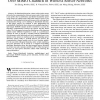901 search results - page 23 / 181 » Minimum power configuration in wireless sensor networks |
CNSR
2005
IEEE
14 years 2 months ago
2005
IEEE
Connectivity in mobile wireless ad-hoc networks is maintained by setting the transmission range so that a node can establish a link to any other node in the network either directl...
IPSN
2005
Springer
14 years 2 months ago
2005
Springer
— We present Telos, an ultra low power wireless sensor module (“mote”) for research and experimentation. Telos is the latest in a line of motes developed by UC Berkeley to en...
CORR
2007
Springer
13 years 8 months ago
2007
Springer
—In distributed detection systems with wireless sensor networks, the communication between sensors and a fusion center is not perfect due to interference and limited transmitter ...
IPSN
2004
Springer
14 years 2 months ago
2004
Springer
Recent advances in technology have made low cost, low power wireless sensors a reality. Clock synchronization is an important service in any distributed system, including sensor n...
LCN
2003
IEEE
14 years 1 months ago
2003
IEEE
Sensor networks are designed especially for deployment in adverse and nonaccessible areas without a fixed infrastructure. Therefore, energy conservation plays a crucial role for t...

